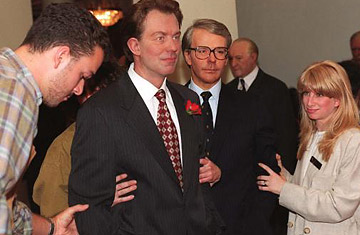
Assistants at Madame Tussaud's move wax effigies of Prime Ministers John Major and Tony Blair.
Addressing a crowd, debating in the House of Commons, or even just working a rope line, Britain's Prime Minister Gordon Brown can seem pretty waxen. Brown's advisors have tried to counter this impression by showcasing the Prime Minister's human qualities. Until this week, that is. On Tuesday, in a startling reversal of its public relations strategy, Downing Street rushed to quash rumors that Brown might be less of a dummy than his predecessor, the consummate orator Tony Blair. A rash of media reports had claimed that Madame Tussaud's, the famous London waxworks exhibition with offshoots in the U.S., continental Europe and China, had delayed commissioning a figure of Brown pending the outcome of the parliamentary election he must hold by June 2010. Blair's waxwork, meanwhile, remains on show, sharing a podium with President Bush. Stung by the rumored snub, Downing Street promptly produced a letter from Nicky Hobbs, the Global Head of External Relations for Madame Tussaud's. It was a request, dated March 3, inviting Brown to "be honored by the Tussaud's team and be amongst the very select group of people that are made into wax figures."
Why the confusion? In February, Tussaud's PR Manager Ben Lovett had told reporters that, in line with standard procedures, a Brown waxwork wouldn't be commissioned until after elections. (Brown inherited the job between elections, after Blair resigned.) A subsequent "significant swell of public support" for Brown triggered the request to Downing Street, says Lovett. That's a rare mismatch between Tussaud's own soundings and the wider world view, because opinion polls reflect no such swell — Labour, under Brown, has actually lost ground to the Tories.
If internet search engines are a spookily accurate digital barometer of contemporary celebrity — in 2007, Google's Top Ten Search terms included Britney Spears, Anna Nicole Smith and Paris Hilton; Gordon Brown didn't feature — Tussaud's is a clunkier analog version of the same thing. It conducts its own polling among its patrons (most visitors come from Britain, Germany, India and the U.S.) and also conducts wider market research to decide exactly which prominent people, living or dead, should be immortalized in a kind of tallow known as "Japan wax". Popularity among the patrons was what won Bollywood star Salman Khan his Tussaud's debut in January. But a dip in popularity can see figures hustled off into storage to make way for fresh exhibits. Still, there's always the possibility of rehabilitation: The chunky singer Gary Barlow was dusted down and reinstalled in the Music Zone after his 1990s boy-band Take That reunited in 2005 and went on to score new hits.
"No one can be considered properly popular unless he is admitted to the company of Madame Tussaud's celebrities," the attraction's eponymous founder, the French-born Marie Tussaud told the British periodical Punch in 1849. But she couldn't resist including a smattering of unpopular characters, too. The so-called Chamber of Horrors still displays an anonymous Sans-Culottes standing close to the decapitated heads of some of the French Revolution's aristocratic victims. Nearby a lifeless Jean-Paul Marat bleeds into his bath.
If Tussaud's imparts a lesson to the schoolkids and tourists who tramp through its labyrinthine exhibits, it's about the pre-eminence of pop culture, and the random nature — and transience — of fame. Hollywood A-listers, sports people and British royals hog the limelight. There are 400-odd figures on show, but all scientific endeavor is represented by Isaac Newton, Stephen Hawking, Charles Darwin, Isambard Kingdom Brunel and TIME's Person of the Century, Albert Einstein, who share a small annex with Vincent Van Gogh, William Shakespeare, Charles Dickens and Oscar Wilde. In the dim light of the first gallery, it looks as if Ivana Trump has made the grade. Closer inspection reveals the figure to be British actress Joanna Lumley in her big-haired role as Patsy from the British TV comedy series Absolutely Fabulous.
Democratic politics provides a challenge to Tussaud's. Angela Merkel, elected German Chancellor in 2005, has been sculpted, but her figure is briefly on loan to Berlin. Her predecessor, Gerhard Schroeder, remains by popular demand. John Howard and Vladimir Putin make an unlikely, and dated, duo. Their successors, Kevin Rudd and Dmitri Medvedev, have not yet been commissioned, but are "very much on our radar," says Lovett.
Dictators, of course, have greater staying power. Ivy Jerrier from Durban in South Africa spots Zimbabwe's despotic leader Robert Mugabe sitting next to Fidel Castro. "I don't want a picture with him," she exclaims, then changes her mind and strikes a pose with her hands around his throat. Tussaud's dispensed with rope barriers five years ago.
If Brown joins this motley crew — and chances are he will (Tussaud's has been rebuffed only once in its history by a would-be subject, and that was Mother Teresa) — he can expect to be poked, prodded, kissed and possibly abused. In a world where fame is valued more highly than respect and pop stars take precedence over playwrights, it's an opportunity not to be missed.
